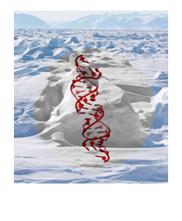2009 Annual Science Report
 Georgia Institute of Technology
Reporting | JUL 2008 – AUG 2009
Georgia Institute of Technology
Reporting | JUL 2008 – AUG 2009
RNA Folding and Assembly
Project Summary
We will characterize the assembly, structure and thermodynamics of the a-PTC by chemical mapping, including hydroxyl radical footprinting1,2 and SHAPE analysis,3 RNase H cleavage, temperature dependent hydrodynamics,4 and computational folding algorithms. In addition we will investigate the effect of freezing aqueous solutions of RNA and DNA molecules on their ability to assemble into larger more complex structures. Freezing nucleic acid solutions concentrates non-water molecules into small liquid pockets in the ice. This enables reactions that can promote the assembly of small segments of nucleic acids into larger complexes.
Project Progress
As described in a previous section of this report, we are resurrecting the a-PTC, which contains a-rRNA, a-rPeptides and inorganic cations. Here we will characterize the a-PTC by a variety of biophysical and chemical methods. The influence of ions, temperature, substrates/inhibitors, and additional environmental factors on folding and assembly will be investigated. The a-PTC and components of it will be probed by chemical mapping, including hydroxyl radical footprinting1,2 and SHAPE analysis,3 temperature dependent hydrodynamics,4 and computational folding algorithms. A first-order approach to characterize the a-RNA’s secondary structure will employ RNase H cleavage5 with random sequence DNA oligonucleotides.

Figure 1. Figure 1. Ice drives the assembly of RNA.
Additional studies are being carried out on the effect of freezing on assembly and folding. Thus far we have observed that micromolar concentrations of 20 nucleotide self-structured RNAs can unfold and refold to form dimers when frozen at -5 C to -20 C. This assembly does not occur above 0 C in solution unless the RNA concentration is increased 100 fold and the concentration of salt in the solution is increased from 0.1 M to 2 M KCl. The dimerization reaction increases as the incubation period is extended from days to week at -20 C. Freezing duplex DNA solutions in weak alkaline medium was also shown to induce strand separation.6
1. Khaitovich, P., Mankin, A. S., Green, R., Lancaster, L. & Noller, H. F. (1999). Characterization of Functionally Active Subribosomal Particles from Thermus Aquaticus. Proc Natl Acad Sci U S A, 96, 85-90.
2. Schulze, H. & Nierhaus, K. H. (1982). Minimal Set of Ribosomal Components for Reconstitution of the Peptidyltransferase Activity. EMBO J, 1, 609-613.
3. Hsiao, C. & Williams, L. D. (2009). A Recurrent Magnesium-Binding Motif Provides a Framework for the Ribosomal Peptidyl Transferase Center. Nucleic Acids Res, 37, 3134-3142.
4. Hsiao, C., Mohan, S., Kalahar, B. K. & Williams, L. D. (2009). Peeling the Onion: Ribosomes Are Ancient Molecular Fossils. Mol Biol Evol, 26, 2415-2425.
5. Hsiao, C., Tannenbaum, M., VanDeusen, H., Hershkovitz, E., Perng, G., Tannenbaum, A. & Williams, L. D. (2008). Complexes of Nucleic Acids with Group I and II Cations. In Nucleic Acid Metal Ion Interactions (Hud, N., ed.), pp. 1-35. The Royal Society of Chemistry, London.
6. Kitahara, K., Kajiura, A., Sato, N. S. & Suzuki, T. (2007). Functional Genetic Selection of Helix 66 in Escherichia Coli 23S rRNA Identified the Eukaryotic-Binding Sequence for Ribosomal Protein L2. Nucleic Acids Res, 35, 4018-4029.
Publications
-
Galyuk, E. N., Wartell, R. M., Dosin, Y. M., & Lando, D. Y. (2009). DNA Denaturation Under Freezing in Alkaline Medium. Journal of Biomolecular Structure and Dynamics, 26(4), 517–523. doi:10.1080/07391102.2009.10507267
-
Mohan, S., Hsiao, C., VanDeusen, H., Gallagher, R., Krohn, E., Kalahar, B., … Williams, L. D. (2009). Mechanism of RNA Double Helix-Propagation at Atomic Resolution †. J. Phys. Chem. B, 113(9), 2614–2623. doi:10.1021/jp8039884
- Updegrove, T., Wilf, N., Sun, X. & Wartell, R.M. (2008). The effect of Hfq on RprA-rpoS mRNA pairing: Hfq-RNA interactions and the influence of the 5’ RpoS mRNA leader region. Biochemistry, 47: 11184-11195.
-
PROJECT INVESTIGATORS:
-
PROJECT MEMBERS:
Lively Lie
Graduate Student
Taylor Updegrove
Graduate Student
Fazila Aseem
Undergraduate Student
Ashley Brouillette
Undergraduate Student
Robin Jacobs
Undergraduate Student
-
RELATED OBJECTIVES:
Objective 3.2
Origins and evolution of functional biomolecules
Objective 5.3
Biochemical adaptation to extreme environments



